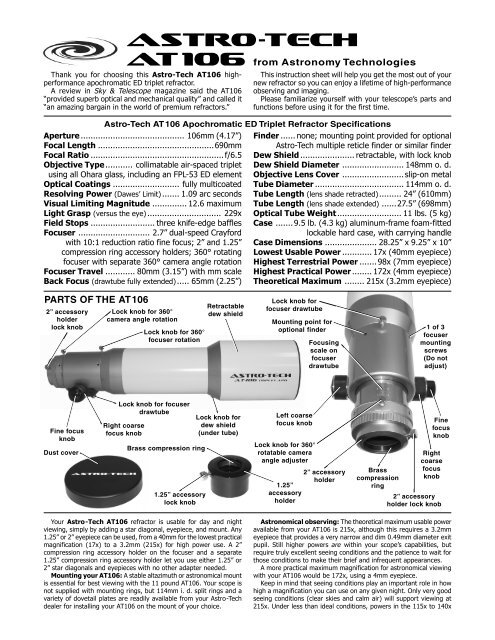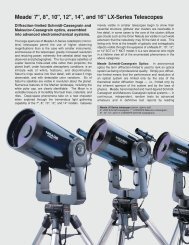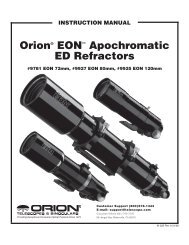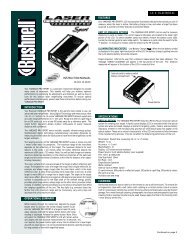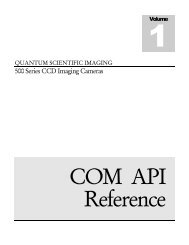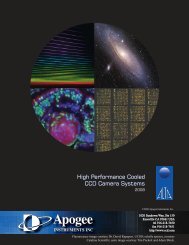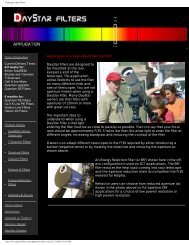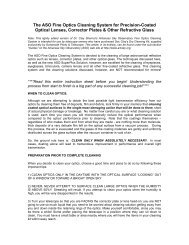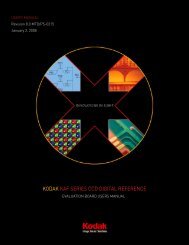Create successful ePaper yourself
Turn your PDF publications into a flip-book with our unique Google optimized e-Paper software.
astro-tech<br />
AT 106 from <strong>Astro</strong>nomy <strong>Tech</strong>nologies<br />
Thank you for choosing this <strong>Astro</strong>-<strong>Tech</strong> <strong>AT106</strong> highperformance<br />
apochromatic ED triplet refractor.<br />
A review in Sky & Telescope magazine said the <strong>AT106</strong><br />
“provided superb optical and mechanical quality” and called it<br />
“an amazing bargain in the world of premium refractors.”<br />
This instruction sheet will help you get the most out of your<br />
new refractor so you can enjoy a lifetime of high-performance<br />
observing and imaging.<br />
Please familiarize yourself with your telescope’s parts and<br />
functions before using it for the first time.<br />
<strong>Astro</strong>-<strong>Tech</strong> <strong>AT106</strong> Apochromatic ED Triplet Refractor Specifications<br />
Aperture .......................................... 106mm (4.17”) Finder ...... none; mounting point provided for optional<br />
Focal Length ...............................................690mm <strong>Astro</strong>-<strong>Tech</strong> multiple reticle finder or similar finder<br />
Focal Ratio ......................................................f/6.5 Dew Shield ...................... retractable, with lock knob<br />
Objective Type........... collimatable air-spaced triplet Dew Shield Diameter ......................... 148mm o. d.<br />
using all Ohara glass, including an FPL-53 ED element Objective Lens Cover .........................slip-on metal<br />
Optical Coatings ........................... fully multicoated Tube Diameter .................................... 114mm o. d.<br />
Resolving Power (Dawes’ Limit)....... 1.09 arc seconds Tube Length (lens shade retracted)......... 24” (610mm)<br />
Visual Limiting Magnitude .............. 12.6 maximum Tube Length (lens shade extended) ......27.5” (698mm)<br />
Light Grasp (versus the eye).............................. 229x Optical Tube Weight.......................... 11 lbs. (5 kg)<br />
Field Stops .......................... three knife-edge baffles Case .......9.5 lb. (4.3 kg) aluminum-frame foam-fitted<br />
Focuser ............................. 2.7” dual-speed Crayford<br />
lockable hard case, with carrying handle<br />
with 10:1 reduction ratio fine focus; 2” and 1.25” Case Dimensions ..................... 28.25” x 9.25” x 10”<br />
compression ring accessory holders; 360° rotating Lowest Usable Power ............ 17x (40mm eyepiece)<br />
focuser with separate 360° camera angle rotation Highest Terrestrial Power .......98x (7mm eyepiece)<br />
Focuser Travel ............ 80mm (3.15”) with mm scale Highest Practical Power ........ 172x (4mm eyepiece)<br />
Back Focus (drawtube fully extended)..... 65mm (2.25”) Theoretical Maximum ........ 215x (3.2mm eyepiece)<br />
PARTS OF THE <strong>AT106</strong><br />
2” accessory<br />
holder<br />
lock knob<br />
Lock knob for 360°<br />
camera angle rotation<br />
Lock knob for 360°<br />
focuser rotation<br />
Retractable<br />
dew shield<br />
Lock knob for<br />
focuser drawtube<br />
Mounting point for<br />
optional finder<br />
Focusing<br />
scale on<br />
focuser<br />
drawtube<br />
1 of 3<br />
focuser<br />
mounting<br />
screws<br />
(Do not<br />
adjust)<br />
Fine focus<br />
knob<br />
Dust cover<br />
Lock knob for focuser<br />
drawtube<br />
Right coarse<br />
focus knob<br />
Brass compression ring<br />
1.25” accessory<br />
lock knob<br />
Lock knob for<br />
dew shield<br />
(under tube)<br />
Left coarse<br />
focus knob<br />
Lock knob for 360°<br />
rotatable camera<br />
angle adjuster<br />
1.25”<br />
accessory<br />
holder<br />
2” accessory<br />
holder<br />
Brass<br />
compression<br />
ring<br />
Fine<br />
focus<br />
knob<br />
Right<br />
coarse<br />
focus<br />
knob<br />
2” accessory<br />
holder lock knob<br />
Your <strong>Astro</strong>-<strong>Tech</strong> <strong>AT106</strong> refractor is usable for day and night<br />
viewing, simply by adding a star diagonal, eyepiece, and mount. Any<br />
1.25” or 2” eyepiece can be used, from a 40mm for the lowest practical<br />
magnification (17x) to a 3.2mm (215x) for high power use. A 2”<br />
compression ring accessory holder on the focuser and a separate<br />
1.25” compression ring accessory holder let you use either 1.25” or<br />
2” star diagonals and eyepieces with no other adapter needed.<br />
Mounting your <strong>AT106</strong>: A stable altazimuth or astronomical mount<br />
is essential for best viewing with the 11 pound <strong>AT106</strong>. Your scope is<br />
not supplied with mounting rings, but 114mm i. d. split rings and a<br />
variety of dovetail plates are readily available from your <strong>Astro</strong>-<strong>Tech</strong><br />
dealer for installing your <strong>AT106</strong> on the mount of your choice.<br />
<strong>Astro</strong>nomical observing: The theoretical maximum usable power<br />
available from your <strong>AT106</strong> is 215x, although this requires a 3.2mm<br />
eyepiece that provides a very narrow and dim 0.49mm diameter exit<br />
pupil. Still higher powers are within your scope’s capabilities, but<br />
require truly excellent seeing conditions and the patience to wait for<br />
those conditions to make their brief and infrequent appearances.<br />
A more practical maximum magnification for astronomical viewing<br />
with your <strong>AT106</strong> would be 172x, using a 4mm eyepiece.<br />
Keep in mind that seeing conditions play an important role in how<br />
high a magnification you can use on any given night. Only very good<br />
seeing conditions (clear skies and calm air) will support viewing at<br />
215x. Under less than ideal conditions, powers in the 115x to 140x
ange provide more consistently usable and pleasing images.<br />
The widest possible field of view with a 1.25” eyepiece is about<br />
2.4°, which can be achieved with a 40mm (17x) Plössl eyepiece having<br />
a 6.15mm exit pupil. A 2” wide field eyepiece, such as the <strong>Astro</strong>-<strong>Tech</strong><br />
40mm Titan Type 2, will give you a 3.95° field at the same power.<br />
Terrestrial observing: Your <strong>AT106</strong> can be used for daytime<br />
birding, nature studies, sweeping the landscape from the home with<br />
a view, etc. – provided it is installed on a suitably sturdy mount. A<br />
good choice would be the <strong>Astro</strong>-<strong>Tech</strong> Voyager altazimuth mount, which<br />
can also be used for grab-and-go astronomical observing. The Voyager<br />
has a 20 pound payload capacity and manual slow motion controls.<br />
Generally speaking, the maximum daytime power with any terrestrial<br />
scope is about 1x per mm of aperture (98x with a 7mm eyepiece).<br />
Attempts to push the power beyond this point often magnify the heat<br />
waves, dust, and “mirage” in our atmosphere to the point where the<br />
images become blurry and unusable. Eyepieces in the 25mm (27x) to<br />
10mm (69x) range are usually more satisfying for daytime use.<br />
Photography with your <strong>AT106</strong>: The <strong>AT106</strong> does an outstanding<br />
job as a wide-field astrograph for CCD and APS-format DSLR<br />
astronomical imaging, particularly when used with the <strong>Astro</strong>-<strong>Tech</strong><br />
#AT2FF 2” field flattener. The <strong>AT106</strong> also makes an excellent 690mm<br />
(13.8x) f/6.5 telephoto lens for terrestrial photography.<br />
The scope’s 2.7” Crayford focuser can be rotated 360° for the best<br />
photographic composition. To rotate the focuser, loosen the chrome<br />
lock knob at the top front of the focuser (its location is shown in the<br />
illustration on the front page). Turn the focuser to the desired angle<br />
and tighten the lock knob to hold it in position. There are three nylon<br />
focuser mounting screws that hold the focuser to the scope body.<br />
They also can be used to adjust the focuser rotation tension (one is<br />
shown in the illustration below). However, they should rarely, if ever,<br />
need adjustment. Excessive or uneven tightening or too-frequent<br />
adjustment of these screws can damage them, a problem not covered<br />
by warranty. They should be adjusted as little as possible.<br />
Focuser adjustments and adjustment no-nos<br />
2” accessory holder lock knob Dust cap<br />
1 of 3 accessory<br />
holder mounting<br />
screws<br />
(Do not adjust)<br />
Examples of the<br />
multiple focuser<br />
mounting screws<br />
and factory<br />
settings<br />
(Do not<br />
adjust)<br />
Lock knob for<br />
focuser drawtube<br />
Camera angle<br />
rotation<br />
adjuster<br />
lock knob<br />
Drawtube tension<br />
adjustment screw<br />
(Adjust only<br />
if absolutely<br />
necessary)<br />
1 of 3<br />
focuser<br />
mounting screws<br />
(Adjust only<br />
if necessary)<br />
In addition to rotating the focuser, it is also possible (and often<br />
more convenient) to simply rotate the 2” accessory holder on the<br />
focuser drawtube to adjust the camera angle for the best photographic<br />
composition, or to put your star diagonal in the most comfortable<br />
observing position.<br />
To rotate the 2” accessory holder, loosen the chrome lock knob<br />
located on the accessory holder in front of the ribbed grip ring (as<br />
shown in the illustration above and on the front page) by turning it<br />
counterclockwise. Rotate the 2” accessory holder to the desired angle,<br />
then tighten the lock knob to temporarily lock the accessory holder in<br />
place at the new angle.<br />
A chrome lock knob under the focuser body (shown above and on<br />
the front page) lets you lock the focuser drawtube at a sharp focus<br />
for photography.<br />
There is a recessed Allen head screw in the underside of the focuser<br />
(as shown above) that lets you adjust the tension on the Crayford<br />
drawtube to accommodate differing accessory loads without slipping.<br />
The tension has been preset at the factory to accomodate most of the<br />
accessory loads the scope will be called on to carry. However, if you<br />
consistently use very heavy equipment trains for CCD imaging, you<br />
might need to adjust the tension. Adjust only if and when needed.<br />
Avoid frequent unneeded adjustment or excessive tightening.<br />
Optional <strong>Astro</strong>-<strong>Tech</strong> accessories: <strong>Astro</strong>-<strong>Tech</strong> makes 1.25” and<br />
2” star diagonals with state-of-the-art 99% reflectivity dielectric<br />
coatings that nicely complement the performance of your <strong>AT106</strong>. These<br />
diagonals are available from your <strong>Astro</strong>-<strong>Tech</strong> dealer to provide the<br />
maximum possible image brightness and planetary detail.<br />
An <strong>Astro</strong>-<strong>Tech</strong> 45° viewing angle image-erecting 1.25” diagonal is<br />
available for correctly-oriented terrestrial observing. An inexpensive<br />
<strong>Astro</strong>-<strong>Tech</strong> non-magnifying illuminated multiple reticle finder is also<br />
available for your <strong>AT106</strong>. The <strong>Astro</strong>-<strong>Tech</strong> Voyager mount mentioned<br />
above is a good choice for casual day and night observing.<br />
Collimating your <strong>AT106</strong>: The black trim ring at the front of the<br />
dew shield can be unthreaded to give you access to the six push-pull<br />
collimation screws around the lens cell. Full collimation instructions<br />
are provided in the separate collimation sheet packed with your scope.<br />
Caring for your <strong>AT106</strong> optics: Never store your telescope in a<br />
damp or humid environment. Avoid leaving it in a hot environment<br />
(exposed to direct sunlight on a window sill, in a car trunk, etc.) If<br />
you must store it in high humidity conditions, put a few packets of<br />
desiccant (silica gel or the equivalent, available from most camera<br />
stores) in with the telescope to absorb excess moisture. If not properly<br />
stored in a humid environment, the telescope may develop mildew<br />
that can damage the optics.<br />
If dew has formed on the scope after a night of observing, allow<br />
the scope optics to air dry at room temperature before putting the<br />
lens cover on the scope and storing it away.<br />
If the front lens surface becomes dusty, smeared, or shows<br />
fingerprints or any other surface build-up, clean the lens using the<br />
following technique.<br />
First, gently blow away any surface dust or particles with a clean<br />
air blower (a child’s ear syringe or a photographer’s camel’s hair brush<br />
with attached blower bulb, for example).<br />
Next, moisten a cloth with a few drops of a photographic-quality<br />
optical cleaning solution designed for use on multicoated camera and<br />
binocular lenses. A well-worn cotton handkerchief works well and<br />
Zeiss, Canon, Nikon, and Kodak all make suitable fluids. Do not drip<br />
the cleaning fluid directly on the lens.<br />
Use the barely damp (not wet) cloth to gently wipe the lens surface<br />
clean with radial strokes, turning the cloth frequently to always keep<br />
a clean portion of the cloth in contact with the lens. Blot the lens dry<br />
with a dry portion of the cleaning cloth or a separate cloth. Start with<br />
a clean cloth each time cleaning is needed.<br />
Avoid overcleaning your scope. The multicoatings on the lens are<br />
quite hard and durable. However, frequent overzealous cleaning can<br />
scratch the coatings if all the dust particles (which are often tiny<br />
flecks of windborne rock) are not removed before you start pushing a<br />
damp cloth around the lens surface. A few specks of dust on the lens<br />
will not be visible in your images. They are not in the focal plane and<br />
do not block enough light to measure, let alone be seen.<br />
Clean your optics only when absolutely necessary. If you take proper<br />
care of your scope, cleaning should rarely be needed.<br />
Caring for your scope finish: Your <strong>AT106</strong> body is finished in a<br />
durable white automotive-grade paint, with grey anodized trim and a<br />
black anodized focuser. The body can become smudged with<br />
fingerprints during use, but these will not harm the finish. A clean<br />
soft cloth slightly dampened with plain water (or a little moisture<br />
from your breath and a quick wipe with a clean handkerchief) is<br />
generally enough to remove any fingerprints.<br />
Avoid harsh chemical cleaners or organic solvents like benzene,<br />
alcohol, etc., as these may ruin the finish. They can certainly affect<br />
the optical coatings if they accidentally drip or splash on the lens.<br />
Caution! Never directly view the Sun with your telescope!<br />
Never aim your <strong>AT106</strong> at the Sun without having a professionallymanufactured<br />
solar filter mounted over the objective lens. Viewing<br />
the Sun through the scope without the proper protection for even a<br />
moment may result in permanent severe damage to your eyes, and<br />
can even cause blindness. Contact your <strong>Astro</strong>-<strong>Tech</strong> dealer if you are<br />
interested in purchasing a compatible professional solar filter.<br />
astro-tech www.astronomytechnologies.com<br />
from <strong>Astro</strong>nomy <strong>Tech</strong>nologies, 680 24th Avenue SW, Norman, OK 73069<br />
© 2009 by <strong>Astro</strong>nomy <strong>Tech</strong>nologies Specifications, features, and descriptions are effective 7/1/2009, but are subject to correction and/or modification without notice and/or obligation.


